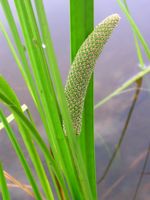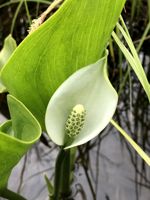Mon-Fri 9am - 5pm Mountain time
American Sweet Flag vs Water Arum
Acorus americanus
Calla palustris
CUSTOM GROW
CUSTOM GROW
American Sweet Flag is a native perennial wetland plant found along shorelines, streams, wet meadows, and marshes. Its extensive rhizome system allows it to spread and stabilise soil, helping maintain the edges of ponds and streams. This dense growth provides cover for small animals and supports overall wetland biodiversity, while the rhizomes and seeds serve as food for small mammals and waterfowl. Cold-hardy and resilient, it is well-suited for ecological restoration, riparian plantings, erosion control, and naturalization projects.
The plant grows in dense clumps with tall, sword-shaped leaves that release a citrus-like scent when bruised. The rhizomes are aromatic, with a spicy, cinnamon-like fragrance that has been used in perfumery and flavouring. In early summer, American Sweet Flag produces a distinctive floral spike (spadix), adding visual interest to wetland plantings.
Water Arum is a native perennial wetland plant known for its showy white oval sheaths (spathe) that surround a yellow-green, cylindrical flower spike (spadix). It has large, oblong, heart-shaped leaves on stems that rise above the water from shallow, spreading rhizomes. The blossoms are followed in late summer by tiny, pear-shaped fruits that ripen to bright red, adding ornamental interest to wet habitats.
Water Arum provides food for birds and small mammals that eat its berries, and its flowers attract pollinators. It can tolerate cold climates and forms colonies in shallow water and saturated soils. It is well-suited for ecological restoration, riparian planting, naturalisation, and habitat projects in wet and shaded environments.
American Sweet Flag Quick Facts
Water Arum Quick Facts
Toxicity: toxic if ingested

